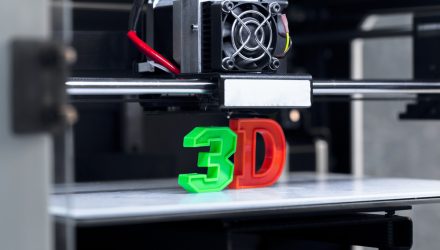Over the past six months, the 3D Printing ETF (CBOE: PRNT), the lone ETF focusing on the 3D printing theme, is higher by an impressive 54%, but it the disruptive technology fund may not be getting the credit it deserves.
What’s more important than the recent strength in PRNT is that there’s an increasingly strong long-term case for the 3D printing ETF.
“According to a new survey from Stratasys subsidiary MakerBot, 74% of respondents plan to invest in 3D printing during the next year,” according to ARK Invest analyst Tasha Keeney. “Including 1,200 participants in 20 sectors, the survey results highlight the advantages that respondents believe 3D printing offers, particularly in the wake of the COVID-19 pandemic.”
ARK believes 3D printing will revolutionize manufacturing by collapsing the time between design and production, reducing costs, and enabling greater design complexity, accuracy, and customization than traditional manufacturing.
3D Thriving: Lots to Like
One of the traits that makes PRNT a compelling long-term idea is the sheer expanse of industry-level applications for 3D printing.
“Notably, 38-46% of the respondents in Military & Defense, Consumer Goods, and Aerospace are using 3D printing to reduce dependence on external suppliers,” notes Keeney. “As the pandemic subsides, many companies are likely to reorganize their supply chains to prevent further disruptions. Not only will it enable manufacturing to take place closer to the end user but 3D printing also will help reduce complications, creating products with new parts and configurations previously impossible with traditional manufacturing methods.”
Passively managed PRNT offers leverage to that department as its benchmark “is composed of equity securities and depositary receipts of exchange-listed companies from the U.S., non-U.S. developed markets and Taiwan that are engaged in 3D printing-related businesses within the following business lines: (i) 3D printing hardware, (ii) computer-aided design (“CAD”) and 3D printing simulation software, (iii) 3D printing centers, (iv) scanning and measurement, and (v) 3D printing materials,” according to Ark.
Interestingly, the coronavirus pandemic could ultimately prove to be a positive long-term catalyst for the 3D printing space.
“Perhaps fallout from the pandemic, particularly the need to lower costs, will force companies to use 3D printing not only for prototyping, which accounts for the vast majority of its use cases now, but also for better and more cost-effective results throughout the production process,” says Keeney. “ARK estimates that 3D printing could grow from a $10-15 billion industry to more than $100 billion in the next 5 years. In hindsight, the pandemic could demarcate its inflection point.”
For more on disruptive technologies, visit our Disruptive Technology Channel.
The opinions and forecasts expressed herein are solely those of Tom Lydon, and may not actually come to pass. Information on this site should not be used or construed as an offer to sell, a solicitation of an offer to buy, or a recommendation for any product.

